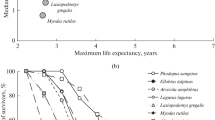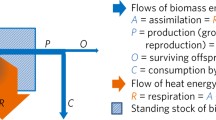Abstract
According to Darwin’s theory of natural selection, the fittest population survives in the course of competition for a food resource. The values of the features of individuals of the surviving population are considered evolutionarily optimal. A model of a biological community consisting of competing populations and a plant resource was built. The model included an equation of population dynamics, an equation of the energy balance of a sexually mature individual, and equations of the dynamics of the density of the food resource. To determine the evolutionarily optimal values, a criterion was proposed by Khanin and Semevsky, according to which the evolutionarily optimal values of features provide the maximum of the reproduction coefficient; it is equal to zero in the equilibrium state of the community. It was shown that there is an equivalent criterion based on the minimum energy received by an individual. Using these criteria, a method for determining the evolutionarily optimal values of body weight and coat thickness of an individual was demonstrated. It was assumed that species-specific lifespan, like other features of an organism, is also a product of evolution. Using the criterion of the minimum energy received by an individual, the species-specific lifespan was determined as a function of external factors and other parameters of the organism. The results were confirmed by numerical experiments for specific values of the parameters.





Similar content being viewed by others
REFERENCES
A. P. Levich, Art and Method in System Modeling (Moskva-Izhevsk, 2012) [in Russian].
A. V. Markov, E. B. Naimark, Quantitative Patterns of Macroevolution (Geos, Moscow, 1998) [in Russian].
N. V. Volosova, Mat. Strukt. Model. 2 (38), 27 (2016).
G. F. Gauze, The Struggle for Existence (Hafner, New York, 1934).
I. F. Obraztsov and M. A. Khanin, Optimal Biomechanical Systems (Meditsina, Moscow, 1989) [in Russian].
R. Rozen, Optimality Principle in Biology (Mir, Moscow, 1969) [in Russian].
F. N. Semevskii, S. M. Semenov, Mathematical Modeling of Ecological Processes (Gidrometeoizdat, L., 1982) [in Russian].
A. T. Terekhin and E. V. Budilova, Zh. Obshch. Biol. 62 (1), 286 (2001).
E. L. Charnov, Lafe History Invariants. Some Exploration of Sinnetry in Evolutionary Ecology (Univ. Press, Oxford, 1993).
J. Kozlovski and J. Weiner, Amer. Nat. 149 (1), 423 (1997).
R. E. Ulanowicz, Ecol. Model. 220 (16), 1886 (2009).
P. V. Fursova, L. P. Levich, and I. L. Alekseev, Usp. Sovrem. Biol. 123 (2), 115 (2003).
I. V. Volvenko, Biofizika 57 (3), 476 (2012).
M. A Khanin, N. L. Dorfman, I. B. Bukharov, and V. G. Levadnyi, Extremum Principles in Biology and Physiology (Nauka, Moscow, 1978) [in Russian].
L. L. Ovsyannikov and V. P. Pasekov, Zh. Obshch. Biol. 51 (5), 709 (1990).
L. L. Ovsyannikov and M. I. Shpitonkov, Biofizika 65 (1), 1171 (2020).
L. L. Ovsyannikov and Yu. M. Svirezhev, Zh. Obshch. Biol. 14 (5), 621 (1983).
L. L. Ovsyannikov, Tr. Inst. Sist. Analiza Ross. Akad. Nauk 69 (2), 78(2019).
L. A. Gavrilov and N. S. Gavrilova, Biology of Life Duration (Nauka, Moscow, 1991) [in Russian].
V. N. Novosel’tsev, Zh. A. Novosel’tseva, and A. I. Yashin, Usp. Gerontol. 12, 149 (2003).
V. P. Skulachev, Life Without Old Age. https://www. atpsynthase.info/Gero/ZhBS – 2013.pdf.
V. K. Kol’tover, Usp. Sovrem. Biol. 96, 85 (1983).
D. Harman, Exp. Gerontol. 33, 95(1998).
M. Kleiber, Higardia 6, 315 (1932).
A. J. Lotka, Elements of Mathematical Biology (Williams and Wilkins, Baltimore, 1925).
Author information
Authors and Affiliations
Corresponding author
Ethics declarations
CONFLICT OF INTEREST
The authors declare that he has no conflicts of interest.
COMPLIANCE WITH ETHICAL STANDARDS
This paper does not contain a description of studies using humans and animals as objects.
Additional information
Translated by E. Puchkov
Abbreviation: SMPL, sexually mature period of life.
Rights and permissions
About this article
Cite this article
Ovsyannikov, L.L. Evolutionary Optimality of Body Features. Species-Specific Lifespan as a Product of Evolution. BIOPHYSICS 67, 835–844 (2022). https://doi.org/10.1134/S000635092205013X
Received:
Revised:
Accepted:
Published:
Issue Date:
DOI: https://doi.org/10.1134/S000635092205013X




